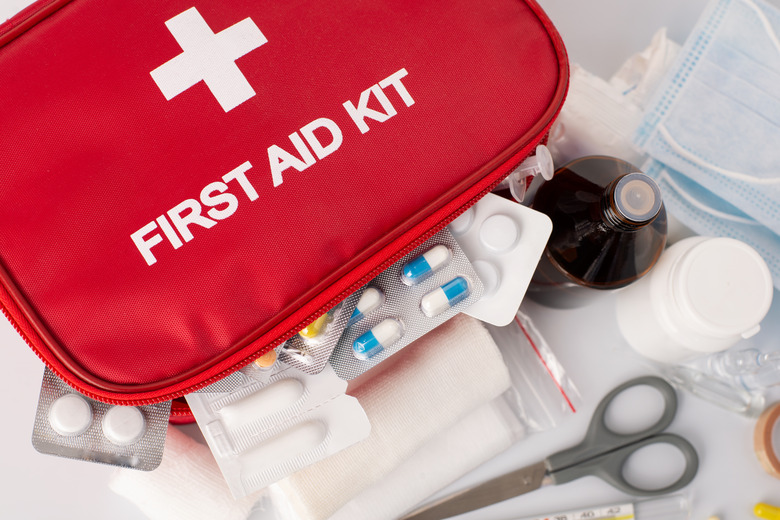These Are The Absolute Essentials You Need For Your Earthquake Kit
We may receive a commission on purchases made from links.
If you live in an area that's prone to earthquakes, you need to protect yourself by being prepared. Pack a comprehensive emergency kit for your home with enough supplies to last each member in your household at least three days. Also pack smaller kits to keep in your automobile and workplace.
Survival Kit at Home
Survival Kit at Home
Every household should have the emergency supplies on hand. Keep the items stored together in a place that's easily accessed by everyone in your household. Although it seems like a large number of items, careful packing can fit a surprising amount into a small space. Plastic bins keep items clean and organized, and they are easy to tote if evacuation becomes necessary.
This home survival kit envisions a worst-case scenario in which a major quake renders food, shelter and medical care temporarily unavailable. Remember that such a scenario may involve partial or complete destruction of your home, so these items should be stored so that they will be easy to find, not scattered around a house that may no longer be easy to access. It is a good idea to store such a kit near the front of the garage or in a backyard shed or outbuilding where the items will be easy to reach even in a worst-case scenario.
If you live in a region where minor quakes are more likely than a major disaster, you can downgrade the kit to the items that are most likely to be necessary.
- First aid kit: A complete kit or one you've assembled on your own (stored in a fishing tackle box or tool box to keep contents dry and portable)
- Water: 1 gallon per person per day for a minimum of three days for drinking and washing
- Food: at least a three-day supply of nonperishable food items for each person.
- Can opener (manual)
- Radio: battery-powered or hand crank with NOAA weather frequency and alert.
- Flashlight
- Batteries
- Whistle
- Pocket knife
- Dust masks
- Plastic sheeting
- Duct tape
- Rope
- Ax, shovel, broom
- Tools: screwdriver, pliers, hammer and adjustable wrench
- Moist towelettes for personal hygiene
- Garbage bags and plastic ties for sanitation
- Local maps
- Cell phone with chargers and backup battery
- Safety pins, needles, thread
- Scissors
- Cash
- Documents in a waterproof, portable container: digital or paper copies of insurance policies, identification and bank account records
- Sleeping bag or blanket for each person in the household
- Tent
- Gloves for cleaning up debris
- Household bleach and medicine dropper to disinfect water
- Fire extinguisher
- Garden hose (siphoning, firefighting)
- Matches in a waterproof container
- Candles
- Hygiene items (bar soap, facial tissues, toilet paper, sunscreen)
- Small plastic storage bags
- Dining kits: paper cups, plates, napkins and plastic utensils
- Paper and pencil
Your list of essential items is household dependent. Since these needs can change, update your kit every year as needed and replace expired items.
- Prescription medications
- Over-the-counter medications, such as pain relievers, anti-diarrhea medication and allergy relief
- Eyeglasses and contact lenses with solutions
- Feminine hygiene supplies
- Infant formula, bottles, diapers, wipes, diaper rash cream
- Pet food and extra water
- Complete change of clothing (appropriate sizes)
- Sturdy shoes to protect from broken glass and debris (appropriate sizes)
- Activities for children: books, puzzles, games
Survival Kit for the Car
Survival Kit for the Car
Store the items for your car survival kit in a small suitcase, bag or backpack for portability.
- Blankets
- Change of clothes and sturdy shoes
- Heavy gloves
- First aid kit and manual
- Nonperishable food, such as protein bars
- Bottled water
- First aid kit and manual
- Moist towelettes
- Prescription medications
- Toilet tissue
- Cash, including coins
- Paper and pencil
- Fire extinguisher
- Rope for towing or rescue
- Tools (pliers, adjustable wrench, screwdriver)
- Jumper cables
- Duct tape
- Emergency signal device (light sticks, flasher, reflector, whistle)
- Flashlight with fresh batteries
- Battery-operated radio with fresh batteries
- Local map and compass
Survival Kit at Your Workplace
Survival Kit at Your Workplace
Your workplace kit should include items you'll need for at least 24 hours.
- Nonperishable food
- Bottled water
- Sweatshirt or jacket
- Sturdy shoes
- Blanket
- Extra pair of eyeglasses or contact lenses and solution
- Small first aid kit
- Essential medications
- Flashlight with fresh batteries
- Battery-operated radio with fresh batteries
- Whistle or other signaling devices
